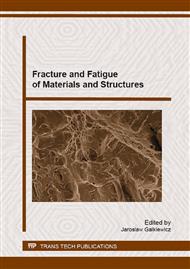[1]
T. Łagoda, Lifetime estimation of welded joints, Springer, Heidelberg, (2008).
Google Scholar
[2]
Marco, S.M.; Starkey, W. L, A concept of fatigue damage, Transactions of the ASME 76, (1954) 627-632.
Google Scholar
[3]
R. Yuan, H. Li, H. Z. Huang, S. P. Zhu, Y. F. Li, A new non-linear continuum damage mechanics model for fatigue life prediction under variable loading, Mechanika, Vol. 19(5), (2013) 506-511.
DOI: 10.5755/j01.mech.19.5.5541
Google Scholar
[4]
Z. Hashin, A. Rothem, A cumulative damage theory of fatigue failure, Air force office of scientific research, Tel Aviv, report nr AFOSR-TR 77-0717, (1977).
Google Scholar
[5]
J. Lemaitre, J.L. Chaboche, Aspect phenorne-nologique dela rupture par endommagement, Journal of Applied Mechanics 2(3), (1978), 317-365.
Google Scholar
[6]
E. Böhm, M. Kurek, G. Junak, M. Cieśla, T. Łagoda, Accumulation of fatigue damage using memory of the material, Procedia Materials Science (2014) 2-7.
DOI: 10.1016/j.mspro.2014.06.002
Google Scholar
[7]
E. Böhm, M. Kurek, T. Łagoda, Accumulation of fatique damages for block – type loads with use of material memory function, Solid State Phenomena Vol. 224, Trans Tech Publications, Switzerland (2015) 39-44.
DOI: 10.4028/www.scientific.net/ssp.224.39
Google Scholar
[8]
L. Yang, A. Fatemi, Cumulative fatigue damage assessment and life predictions of as-forged vs QT V-based MA steels using two-step loading experiments, Proceedings of the Institution of Mechanical Engineers, Part L: Journal of Materials: Design and Applications, vol. 217 no. 2, 2003, pp.145-155.
DOI: 10.1177/146442070321700206
Google Scholar
[9]
S. Ishiyama, M. Eto, Effect of stress history on cumulative fatigue damage of fine-grained isotropic GCR graphite, Elsevier Science Ltd., Carbon Vol. 34, No. 8, 1996, pp.967-974.
DOI: 10.1016/0008-6223(96)00036-x
Google Scholar
[10]
K. J. Miller, K. P. Zachariah, Cumulative damage laws for fatigue crack initiation and stage I propagation, The Journal of Strain Analysis for Engineering Design, vol. 12 no. 4, 1977, pp.262-270.
DOI: 10.1243/03093247v124262
Google Scholar
[11]
Y. Lee, J. Pan, R. Hathaway, M. Barkey, Fatigue Testing and Analysis: Theory and Practice, Elsevier, 2004, p.402.
Google Scholar


